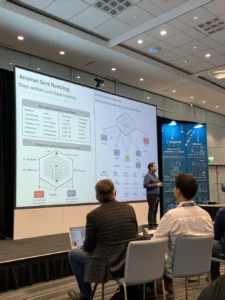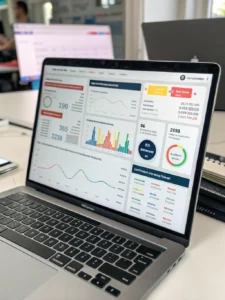Supercharge Your Finance Department: A Step-by-Step Guide to Robotic Process Automation
The Future of Finance is Here: How Robotic Process Automation is Revolutionizing the Department The finance industry is undergoing a seismic shift, driven by technological advancements and the ever-increasing demand for efficiency, accuracy, and real-time insights. At the heart of this transformation lies robotic process automation finance department (RPA), a technology poised to reshape how financial institutions operate, manage risk, and serve their clients. But what exactly is RPA and how can it be applied to alleviate common pain points within the finance department, freeing up human capital for more strategic endeavors? This blog post will delve into the power of RPA in finance, exploring practical applications, emerging trends, and the strategic considerations required for successful implementation. From streamlining accounts payable to enhancing regulatory compliance, we’ll uncover how organizations are leveraging automation to gain a competitive edge and build a more resilient future. What is Robotic Process Automation (RPA) and Why is it Crucial for Finance? RPA is essentially the use of software robots – also known as bots – to automate repetitive, rule-based tasks that humans typically perform. These bots mimic human actions interacting with software applications to execute processes without requiring manual intervention. Unlike traditional automation software, RPA doesn’t require significant changes to existing IT systems; instead, it works on top of them, making it a relatively quick and cost-effective way to digitize workflows. The finance department is particularly well-suited for RPA implementation, owing to the prevalence of standardized, data-driven processes. Tasks like data entry, invoice processing, reconciliation, and report generation are prime candidates for automation. The benefits are manifold: Increased Efficiency: Bots work 24/7, performing tasks faster and more consistently than humans. Reduced Errors: Automation minimizes the risk of human error, leading to more accurate financial reporting. Cost Savings: By automating repetitive tasks, organizations can reduce labor costs and improve resource allocation. Improved Compliance: RPA can help enforce regulatory requirements and ensure data integrity. Enhanced Employee Satisfaction: freeing up employees from mundane tasks, they can focus on higher-value activities. Many organizations are already experiencing the ROI of embracing rpa in finance. Key Applications of RPA in the Finance Department The possibilities for RPA in finance are vast and continue to expand. Here are some of the most common and impactful applications: 1. Accounts Payable Automation Accounts payable (AP) is often a bottleneck in finance departments. RPA can automate invoice processing by extracting data from invoices, matching them to purchase orders, and routing them for approval. This drastically reduces processing time and minimizes the risk of late payments. Bots can handle various invoice formats (PDF, scanned images, etc.) and integrate with existing accounting systems. 2. Reconciliation Processes Reconciling bank statements, credit card statements, and other financial records can be time-consuming and prone to errors. RPA can automate these processes by extracting data from financial statements, comparing them, and flagging discrepancies for human review. 3. Financial Reporting & Analysis RPA can automate the generation of financial reports by extracting data from various sources and compiling it into a standardized format. It can also assist with data analysis by pulling data from different systems and creating visualizations. This allows finance teams to make data-driven decisions more quickly. 4. Customer Onboarding & KYC (Know Your Customer) RPA can streamline the customer onboarding process by automating data collection, verification, and compliance checks. This is especially valuable for financial institutions subject to strict KYC regulations. 5. Expense Management Automating the processing of employee expense reports—capturing data, verifying receipts, and reconciling expenses—free up HR and finance personnel. The Rise of AI-Powered RPA: The Next Frontier in Finance Automation While traditional RPA is powerful, the integration of Artificial Intelligence (AI) is taking automation to the next level. This evolution, often termed Intelligent Automation, empowers RPA bots with cognitive capabilities, allowing them to handle more complex and unstructured tasks. AI-powered RPA can: Understand Natural Language: Process requests expressed in plain language, eliminating the need for rigid, pre-programmed commands. Learn and Adapt: Automatically adjust workflows based on changing data patterns and business rules. Process Unstructured Data: Extract information from documents with varying formats and layouts. Make Decisions: Automate more complex decision-making processes based on predefined criteria. For example, AI-driven RPA can analyze customer feedback from various sources to identify potential risks and improve customer service. The overlap between AI Agents and rpa in finance is growing rapidly. Application Traditional RPA AI-Powered RPA Invoice Processing Rule-based Handles varied formats and extracts data smarter Reconciliation Simple Matching Handles discrepancies and learns from patterns Financial Reporting Data Extraction Analyzes data, identifies trends Customer Onboarding Data Entry Automates compliance checks and risk assessment Expense Management Basic Verification Processes receipts & detects anomalies Strategic Considerations for Successful RPA Implementation Implementing RPA is not simply a technology upgrade; it requires a strategic approach. Here are some key considerations: Identify the Right Processes: Start with low-hanging fruit – repetitive, high-volume tasks that are well-defined. Data Quality is Crucial: RPA bots rely on accurate data. Invest in data cleansing and validation to ensure data integrity. Change Management: Clearly communicate the benefits of RPA to employees and provide training to ensure a smooth transition. Security Considerations: Implementing robust security measures to protect sensitive financial data is paramount. Scalability: Choose an RPA platform that can scale to meet your evolving needs. Considering the Role of AI Agents and Automation As AI Agents, a form of AI-powered automation, gain traction, they dramatically improve the potential of robotic process automation finance department. AI Agents can not only perform tasks but can also proactively identify inefficiencies, propose solutions, and even handle exceptions with minimal human intervention. This represents a significant evolution beyond traditional rules-based RPA, bringing more intelligence and dynamism to financial workflows. Conclusion: Embracing the Future of Finance with RPA The future of finance is undoubtedly automated. Robotic process automation finance department is no longer a futuristic concept; it's a tangible reality transforming how financial institutions operate. By embracing RPA and incorporating AI-powered capabilities, organizations can unlock significant efficiencies, reduce errors, and empower their employees to focus on strategic initiatives. The move towards rpa in finance is not merely about cost-cutting; it's about building a more agile, resilient, and data-driven future. What are your thoughts on RPA? Share your experiences or questions in the comments below! Don't forget to share this article with your network and explore other resources on BlogTechi for more insights on emerging technologies. You can also learn more about UIPATH's solutions for finance automation
Share this content:














Post Comment